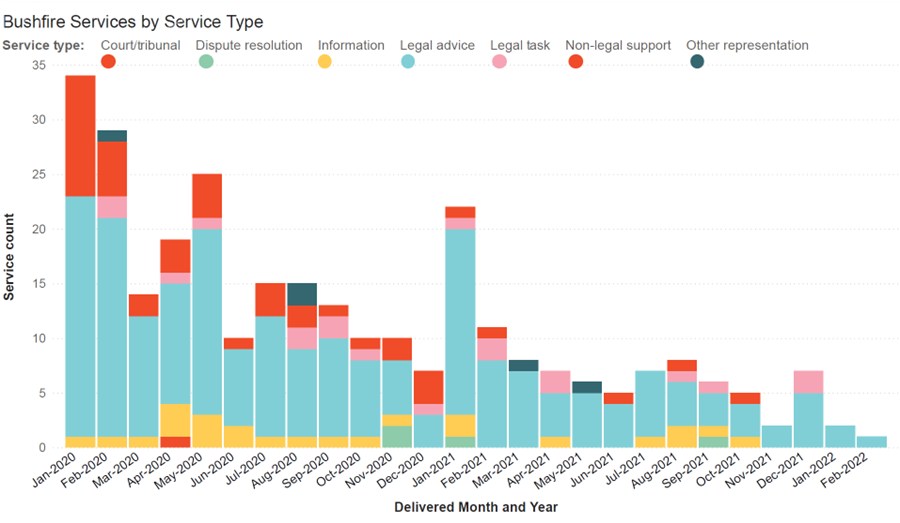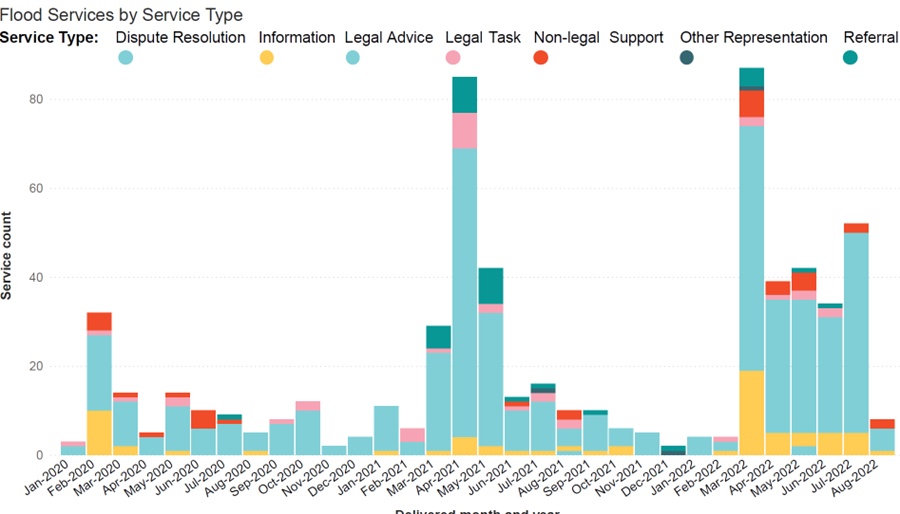November 2022: Data story – Climate justice and disaster response
Lots of the money that flowed to the sector in the October federal budget targeted centres engaged in climate justice and disaster response work. The government restored federal funding to the Environmental Defenders Office, delivered $12 million over four years to twelve centres in Queensland and NSW supporting communities impacted by flooding in early 2022. As climate change worsens the frequency and intensity of extreme events, it’s timely to review the data we hold about our sector’s work to support impacted people and communities and think about how we can improve our data holdings to track impacts, emerging legal needs, and our sector’s unique value add to climate justice and disaster response work.
For this month’s data story, we look at the qualitative and quantitative data we hold on the sector’s work in climate justice and disaster response. From August to September, our Wotton + Kearney secondee, Renee Magee, interviewed people from across the sector and analysed available CLASS data.
Legal needs change as the disaster cycle progresses. As time goes on, the nature and complexity of these problems change. Interviewees identified a consistent pattern to when common legal problems caused by disasters emerge. Immediately after a disaster, centres spend most of their time advising on insurance claims, accessing disaster grants and social security payments. However, many problems only emerge months or even years after an event, including complex property and planning law disputes. Over the longer term, centres also reported a rise in legal assistance tied to mental health, employment disputes. family law and family violence. Interviews also highlighted that the bulk of our sector’s disaster response involves community education and engagement, including awareness-raising through outreach services, delivering education sessions, producing information sheets, or referring people in the right direction.
While limited, the quantitative data we hold in CLASS is consistent with what centres told us through interviews. Currently, CLASS doesn’t include a single category to capture disaster or climate-related legal problems. However, Financial Rights Legal Centre has developed an innovative solution, using CLASS’s keyword function to tag disaster-related services and identify the type of disaster they relate to. CLASS data about services provided through its national Insurance Law Service tells a similar story about how the changing climate and increasing disasters impact our sector’s service delivery.

This graph shows a significant spike in insurance legal services following the Black Summer bushfires in 2019-2020, with high demand for assistance continuing for several months. Similarly, the graph below shows requests for assistance with insurance problems spiking a month or so after the east coast floods in March 2021 and again a month or so after the second wave of flooding hit in February 2022.

The graphs also show the breakdown legal services provided. In order, the top three service types Financial Rights provided after these disasters were legal advice, non-legal support and information. This reflects the critical role community legal centres play in advising and educating people and communities about their legal rights after a disaster and highlights the critical need for our sector to be well-prepared and resourced to respond when disasters hit.
Robust data on how climate change impacts legal needs in our communities and what centres are doing to respond would provide a powerful tool for service planning, funding advocacy and wider law reform work. Conversations about our National Dataset need to include how we best capture this data. Establishing a unique, mandatory field to identify climate-related legal problems and services is one way we could identify high-risk communities and emerging legal needs, provide a robust evidence base for advocacy and law reform efforts, and support better service delivery to our communities.